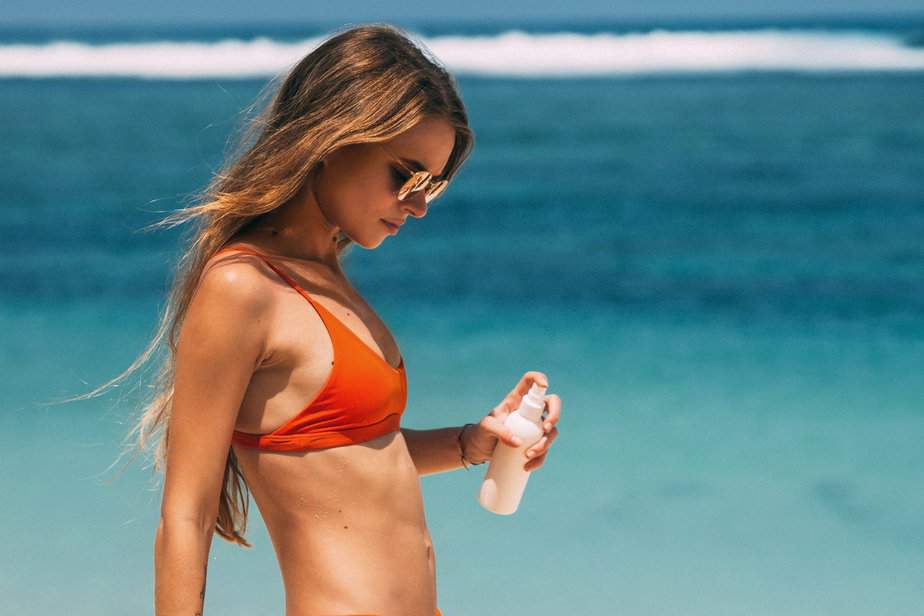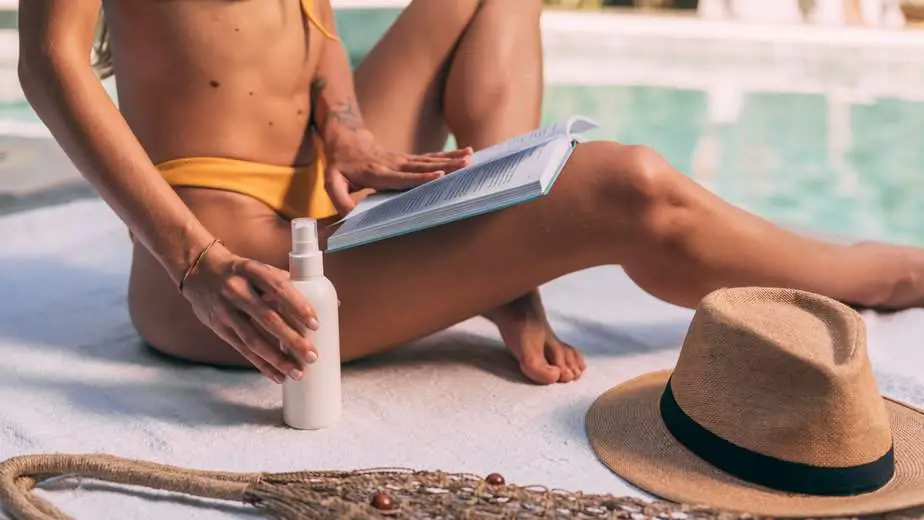Sunscreen is an essential product everyone should use if they are going to be spending time outdoors in the sun. It protects your skin from the sun’s UV rays which can rapidly age your skin, cause sunburn, and potentially cause skin cancer long-term.
UV rays also cause your skin to produce melanin, which is a pigment that protects the skin from UV rays but also has the aesthetic benefit of darkening your skin, giving you a tan.
By wearing sunscreen, you are preventing most UV rays from reaching your skin, avoiding these harmful effects. However, you are also making it harder to get tanned, which some see as a negative. That said, foregoing sunscreen and exposing yourself to UV damage is not a good solution either, but you will tan faster. The “safest” way to tan is to wear a broad-spectrum, water-resistant sunscreen that is SPF-15 and just spend time outdoors in the sun.
In this article, we will discuss how sunscreen works, what is really happening to your skin when you get a tan, and why purposely getting a tan might not be something you should desire. We also discuss how you can get a tan in the safest way possible and other tanning tips, though suntanning is generally not recommended.
What is really happening when you tan

Suntanning has been very popular among women since as early as the 1950’s. Women with swimsuit tan lines were seen as extremely attractive, and women flocked to the beach in revealing bathing suits to get a tan. Not much has changed since then. Well, there’s one major difference actually.
Unlike the 50’s when we knew very little about how dangerous UV rays were (most people still thought smoking was safe back then), nowadays we know much better. We know that UV radiation causes skin wrinkles, sunburn, skin cancer, and yes, a darkening of the skin. And yet, getting a deep tan is still seen as desirable in modern culture which is why so many people ignore the dangers.
When you’re getting a tan, what is really happening is your skin is responding to UV damage. The skin is producing a pigment called melanin which darkens the skin and provides some natural sun protection.
However, our natural sun protection is inadequate, equal to about SPF 3 to 4 when the minimum sunscreen SPF value is 15. We’ll discuss SPF values in-depth in the next section, but this is a huge difference just based on the numbers.
For emphasis, any tanning that occurs is your skin’s response to UV damage. It is NOT a good thing, despite our culture valuing it highly for cosmetic purposes. Any tanning damage increases your risk of skin cancer which can be lethal.
Why sunscreen is so important

Now that you know the major risks of exposing your skin to UV radiation, it should be pretty obvious why sunscreen is vital when you’re at the pool, beach, or anywhere outdoors while you’re showing skin.
Sunscreen acts as a filter that prevents the majority of UV rays from reaching your skin, drastically limiting the damage they can do. Effective as it is, sunscreen does not block all the UV rays, which is why you can still tan at some level even with sunscreen on.
Earlier we mentioned SPF. That stands for sun protection factor, which is a measure of how effective a sunscreen is at blocking UV rays. The three most common SPF values are 15, 30, and 50. The higher the SPF value, the more UV rays it blocks.
It’s worth mentioning that the SPF value is not linearly effective; SPF 50 sunscreen is not, for instance, more than three times more effective than SPF 15 sunscreen. To illustrate this more clearly, here are the SPF values expressed as a percentage of how many UV rays each can block:
- SPF 15: 93% UV ray block rate.
- SPF 30: 97% UV ray block rate.
- SPF 50: 99% UV ray block rate.
As you can see, even SPF 15 sunscreen is quite good, boasting a 93% UV block rate. If you have fair skin and burn easily, then consider wearing sunscreen that is at least SPF 30 or higher.
With regards to tanning, the higher the SPF value of a sunscreen, the harder it will be to tan. If you still want to tan but don’t want to be completely exposed to UV rays, then you should be wearing SPF 15 sunscreen. Again, tanning is technically skin damage and it is NOT good for you.
Furthermore, it is important to specifically get broad spectrum, water-resistant sunscreen. Broad spectrum means that it protects against both UVA and UVB rays for total protection, and the water resistance is so that it does not wash off so easily or quickly when exposed to sweat or water.
The safe way to tan
- SELF TANNER: Our most iconic & foolproof self tan - lightweight & quick-drying formula for a beautiful streak-free natural-looking tan
- BEAUTY PRODUCTS: This trusted fake tan develops into a natural golden glow that lasts up to 10 day wear
- SKINCARE: Infused with hydrating jojoba oil & other skincare actives enjoy a hydrated & long-lasting glow
This heading is a bit of a misnomer, because tanning is inherently dangerous and not recommended. The only real safe way to tan is by sunless tanning via using a spray tan or tanning lotion.
These products will give you an artificial tan so that you can reap the benefits of looking tanned with none of the downsides. That said, not all tanning lotions or spray tans include sunscreen, meaning as you show off your tan, you will be getting a real tan at the same time which is bad as we mentioned. Look for sunless tanners that include sunscreen or wear sunscreen over the tanner yourself.
And again, you can still get a tan while wearing sunscreen. Just spending enough time outdoors, even with sunscreen on, will eventually result in tanning because not all UV rays are blocked by the sunscreen, so minor skin damage can still occur.
Don’t forego sunscreen just to tan faster

I understand the information provided in this article may not be what you want to hear. After learning that wearing sunscreen makes it harder to tan, you might simply decide not to wear any until you’ve gotten a tan first, and then wear sunscreen afterwards to limit further damage.
Once again, I have to stress that getting a tan is not healthy for your skin. It’s the result of skin damage due to UV radiation. Do not be influenced by the cultural zeitgeist and get a tan in spite of the overwhelming evidence that exposing your skin to UV radiation is dangerous.
If you do decide to get a tan by not wearing sunscreen, or possibly accelerating the process even further by using tanning oil, then you are subjecting your skin to an intense amount of UV radiation. It will be difficult to control how your skin reacts to this, and you can easily get sunburned.
Furthermore, constant exposure to UV rays causes photoaging, which is the premature aging of the skin. In other words, you will look much more wrinkly at a younger age if you do not limit how much UV rays you are exposed to.
I don’t know about you, but a concentrated blast of UV radiation does not sound like a good idea to me. You should just wear sunscreen and let whatever rays slip through be your only sources of UV rays.
If you really want to look tan, again, the safest ways are to use spray tans or tanning lotion. Do not worry about whether sunscreen helps you tan better or not; that’s not the question you should be asking. Do not think of a tan as a good thing; it’s the result of skin damage and is not healthy.
Last update on 2025-06-29 / Affiliate links / Images from Amazon Product Advertising API


